the value English is repeating again and again. Is this a repeating
group?
No. The multiple appearances of English in SUBJECT_MODULE are not a repeating group or even either of the two things that people mistakenly mean by a repeating group. They are also not evidence of redundancy or lack of normalization. Such multiple appearances might be connected to redundancy or normalization, but they appear all the time when there is no redundancy and various levels of normalization.
If SUBJECT_MODULE is rows where "[SUBJECT_NAME] has [MODULE_NAME] identified by [MODULE_ID]" and a subject might have more than one module then somewhere you must have multiple mentions of that subject (perhaps via its name) with mentions of different modules (perhaps by name or id). That would not involve redundancy.
Student Age Subject
Adam 15 Biology
Adam 15 Maths
Alex 14 Maths
Stuart 17 Maths
The redundancy in this example from your question's second "this" link is not that Adam appears in two rows or that Adam appears with 15 in two rows. It is that if the table is rows where "[Student] is [Age] years old and takes [Subject]" then Student (eg Adam) can appear in multiple rows but always appears with the same Age (eg 15). But if the table were rows where "[Student] has a friend [Age] years old in [Subject]" then the table could be fully normalized already.
Sure it gets rid of the repeating value, but I am not sure if this is
the right thing.
It does for your example data, but it might not for other example data. You haven't told us enough. (Anyway as I said above the multiple appearances might not even need normalizing.)
Whether there are any normalization-relevant redundancies in SUBJECT_MODULE or even whether there are any valid decompositions including the one you gave depends on the usual information necessary to normalize to above 1NF. Namely whether some of its columns are functions of others (functional dependencies) and whether its rows are also those where "..." AND "..." (join dependencies).
By giving a possible decomposition you have said that it is also rows where "...[Subject_Name]...[Module_ID]..." AND "...[Module_Name]...[Module_ID]..." And you have given some example decomposition data. But we only know that it could be so decomposed because you added the decomposition. And the decomposition plus data still isn't enough for us to know whether it should be so decomposed.
I have read different tutorials and seen different examples of
normalization, specially the notion of "repeating groups" in the first
normal form.
"Repeating groups" are something from pre-relational databases and cannot possibly appear in a relational table (relation). They are like a named set of values that is like a field of a record but is not quite. A relational table is always in 1NF. Each column of a row has a single value of the column's type. A non-relational database is "normalized" to tables ie 1NF (first sense of "normalized") which gets rid of repeating groups. Then those tables/relations are "normalized" to higher normal forms (second sense of "normalized").
A relational table having multiple similar columns or having a column type with multiple similar parts are each just reminiscent of having a repeating group in a non-relational database. And the multiple columns and parts should become multiple rows in a separate table, just like the multiple members of a repeating group. But these problems have to do with relational quality of design, not repeating groups or normalization (in either sense) or being relational (ie being in 1NF).
Note that a non-relational database might itself have similar problems with multiple similar fields and/or named sets or with multiple similar parts of values of fields. Normalization to tables does not get rid of these when it gets rid of repeating groups.
Regardless of how they got into a relational design, removing them gives a "better" design. It is just because these design problems are reminiscent of repeating groups that people get confused and imagine that somehow a table could contain a repeating group. So the multiple similar columns and values with multiple similar parts (or the parts) get incorrectly called "repeating groups".
See this answer re "atomicity".
 In this example, the value English is repeating again and again. Is this a repeating group?
If I eliminate it to make another table SUBJECT with Subject Name and Module_ID(Foreign key), this is what I get. Sure it gets rid of the repeating value, but I am not sure if this is the right thing. Is it right?
In this example, the value English is repeating again and again. Is this a repeating group?
If I eliminate it to make another table SUBJECT with Subject Name and Module_ID(Foreign key), this is what I get. Sure it gets rid of the repeating value, but I am not sure if this is the right thing. Is it right?
